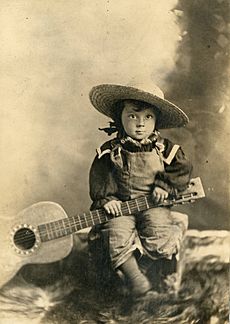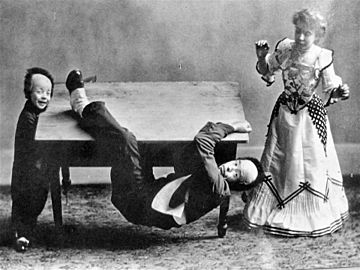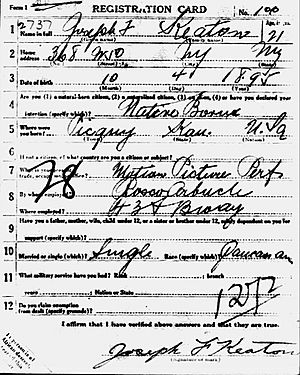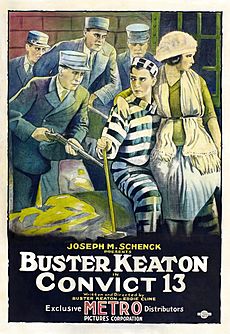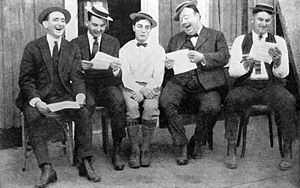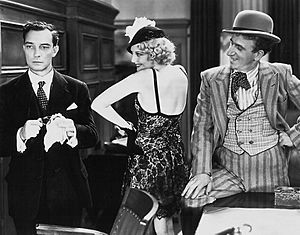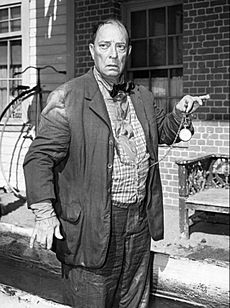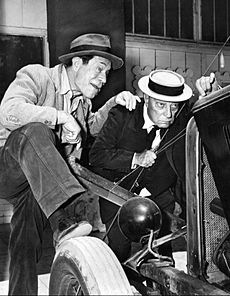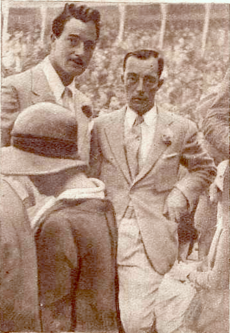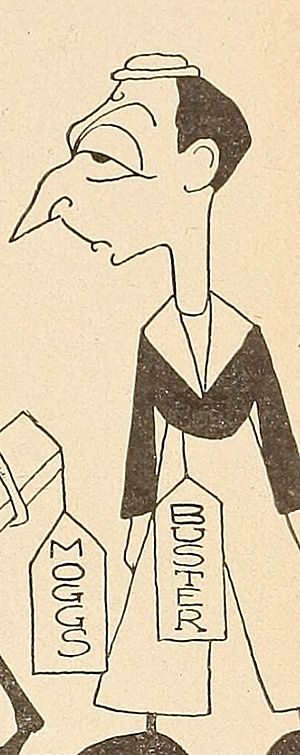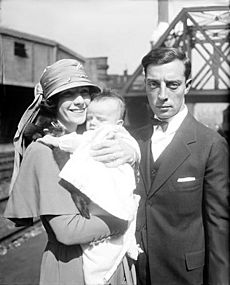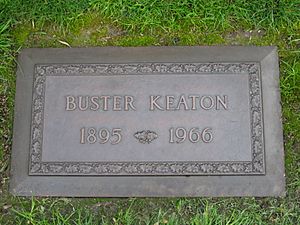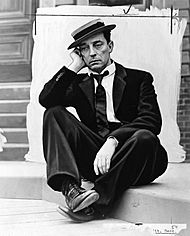Buster Keaton facts for kids
Quick facts for kids
Buster Keaton
|
|
|---|---|
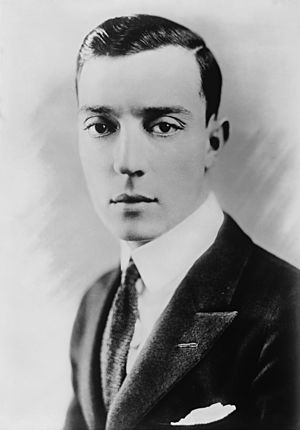 |
|
| Born |
Joseph Frank Keaton
October 4, 1895 Piqua, Kansas, U.S.
|
| Died | February 1, 1966 (aged 70) Woodland Hills, California, U.S.
|
| Resting place | Forest Lawn Memorial Park, Hollywood Hills, California |
| Occupation |
|
| Years active | 1899–1966 |
|
Works
|
Full list |
| Spouse(s) |
Natalie Talmadge
(m. 1921; div. 1932)Mae Scriven
(m. 1933; div. 1936)Eleanor Keaton
(m. 1940) |
| Children | 2 |
| Parents |
|
Joseph Frank "Buster" Keaton (born October 4, 1895 – died February 1, 1966) was an American actor, comedian, and filmmaker. He is famous for his work in silent films. His special style was physical comedy, where he kept a serious, unsmiling face. This earned him the nickname "The Great Stone Face."
Many people think Keaton was one of the greatest actor-directors in movie history. He understood how movies worked. He was like a "visual mathematician" who created amazing physical stunts. In 1999, the American Film Institute named him one of the top male stars of classic Hollywood.
In the early 1920s, Keaton made many successful short comedies. These included One Week (1920) and Cops (1922). He then started making full-length movies. Films like Sherlock Jr. (1924), The General (1926), and Steamboat Bill, Jr. (1928) are still loved today. Many consider The General his best work.
Keaton's career changed when he joined Metro-Goldwyn-Mayer (MGM). He lost some of his freedom to make films his own way. Later in his life, he became a respected comic performer again. He even received an Academy Honorary Award in 1959. He also made guest appearances in movies like Sunset Boulevard and Limelight.
Many people say Keaton was ahead of his time. He was like the first action hero. His films had exciting action and clever stories. For example, in Steamboat Bill, Jr., he goes through many wild events during a storm. In Sherlock Jr., he dreams himself into a movie. His film The General is a mix of comedy, romance, and history.
Contents
His Career in Entertainment
Early Life in Vaudeville Shows
Buster Keaton was born in Piqua, Kansas, in 1895. His parents, Joe and Myra Keaton, were vaudeville performers. Vaudeville was a type of live stage show with different acts. Buster was named Joseph Frank. He was the sixth Joseph Keaton in his family.
When he was about 18 months old, he got his famous nickname, "Buster." A family friend, George Pardey, saw him fall down some stairs without getting hurt. Pardey said, "Gee whiz, he's a regular buster!" A "buster" meant someone who was tough or strong.
At age three, Buster started performing with his parents in their act called "The Three Keatons." He first appeared on stage in 1899. Their act was a comedy sketch. Young Buster would misbehave, and his father would playfully throw him around the stage. A special handle was sewn into Buster's clothes to help with this.
Buster learned how to take these falls safely. He was rarely hurt. People called their act "The Roughest Act That Was Ever in the History of the Stage." Buster later said he was never hurt by his father. He learned how to land softly, like a cat.
At first, Buster would laugh during the act. But he noticed the audience laughed less when he did. So, he started keeping his face serious, which became his famous "deadpan" expression.
Laws sometimes tried to stop child performers. But Buster always showed authorities he was fine. He was even called "The Little Boy Who Can't Be Damaged." He learned to read and write later in life, taught by his mother. When he was 21, he moved to New York. His career quickly shifted from vaudeville to making movies.
During World War I, Buster served in the United States Army in France. He got an ear infection that affected his hearing for the rest of his life.
Making Movies
Silent Movies
In 1917, Buster met Roscoe "Fatty" Arbuckle in New York City. Arbuckle was a famous comedian. Buster was asked to try acting in a film right away. He was so good in his first movie, The Butcher Boy, that he was hired on the spot. He even took a camera apart and put it back together to understand how it worked.
Buster appeared in 14 of Arbuckle's short films. In these early films, he sometimes smiled or laughed. In 1920, he got his first main role in a full-length movie called The Saphead.
After working with Arbuckle, Buster got his own film company. He made many popular two-reel comedies. These included One Week (1920) and The Playhouse (1921). Then, he started making full-length movies.
Buster often came up with his own amazing stunts and jokes. These stunts were very dangerous. In Sherlock Jr., a torrent of water fell on him from a water tower. He broke his neck but didn't know it until years later.
In Steamboat Bill, Jr., a two-ton building facade falls on him. He stands still, and a window opening in the facade perfectly frames him. He comes out unharmed. This stunt needed incredible precision. It became one of his most famous movie moments.
Other well-known silent films include Our Hospitality (1923) and The Navigator (1924). His film The General (1926) was set during the American Civil War. It mixed physical comedy with Buster's love for trains. The film had an exciting train chase. It was based on a real event.
The General was very expensive to make. The scene where a train falls through a burning bridge was the most expensive single shot in silent film history. At the time, the film got mixed reviews. Some people thought it was too serious for a comedy. After this, Buster didn't have as much control over his films.
He then signed with Metro-Goldwyn-Mayer (MGM), a big Hollywood studio. This move meant he lost his freedom to make films his own way. This happened as sound films were becoming popular. These changes caused problems for his career.
Challenges at MGM
In 1928, Buster signed a contract with MGM. Other comedians like Charlie Chaplin warned him he would lose his independence. But Buster agreed, calling it the worst business decision of his life.
At MGM, everything was planned and budgeted by the studio. They wanted Buster the star, but not Buster the creator. They thought it took too long for him to develop his own ideas.
When sound films became popular, Buster was excited. But MGM often made him use a stunt double for dangerous scenes. This was something he never did before. Buster believed stuntmen didn't get laughs.
In his first sound films, he had to shoot each scene three times. Once in English, and then in two other languages like Spanish or French. He had to memorize the foreign scripts line by line. He said it was hard to shoot bad films three times.
Buster kept trying to do things his way. But the studio often made him use their scripts. He made a film called Sidewalks of New York (1932). He didn't like the story, but it became his biggest box office success.
MGM also paired him with other comedians like Jimmy Durante. They made three successful films together. But Buster felt very unhappy. MGM fired him in 1933, even though his last film was a hit. After this, he made a few independent films in Europe.
Educational Pictures and Gag Writer
When Buster returned to Hollywood in 1934, he made short comedies for Educational Pictures. These films were mostly visual comedies. Buster often used old ideas from his vaudeville days. He had more freedom to stage these films.
In 1937, Buster went back to MGM as a gag writer. He helped create jokes for films like the Marx Brothers movies. He also directed a few short films, but didn't get more directing jobs.
Columbia Pictures and Later Films
In 1939, Columbia Pictures hired Buster to star in 10 short comedies. These films often had lots of slapstick comedy. Moviegoers liked them.
In 1940, Buster married Eleanor Norris. This helped stabilize his personal life. He continued to work as a gag writer at MGM. He helped stars like Red Skelton and Lucille Ball.
Buster also took on different acting roles in movies. He made his last starring film, El Moderno Barba Azul (1946), in Mexico. Some people consider it one of the worst films ever made.
Later, critics rediscovered his silent films. He started getting roles in bigger movies. He had small parts in films like Sunset Boulevard (1950) and Around the World in 80 Days (1956). In In the Good Old Summertime (1949), he even directed stars Judy Garland and Van Johnson in a funny scene.
He also appeared with Charlie Chaplin in Limelight (1952). This was the only time these two famous comedians appeared together in a film.
Television and Rediscovery
In 1949, Buster started appearing on television. His TV appearances helped people rediscover his silent films. He guest-starred on many popular shows. He often recreated his old routines. Even in his fifties, he could still do amazing falls.
In 1954, Buster and his wife Eleanor worked with film programmer Raymond Rohauer. They helped re-release his old films. Many of his classic movies were found and saved.
Buster also appeared in many TV commercials. He promoted products like Colgate and Alka-Seltzer. In 1962, he made silent TV commercials for Simon Pure Beer. He used some of his old gags from his silent film days.
His big-screen career continued too. He had a cameo in It's a Mad, Mad, Mad, Mad World (1963). He also starred in the short film The Railrodder (1965) for the National Film Board of Canada. In this film, he traveled across Canada on a motorized cart, doing his classic gags. This was his last silent screen performance.
He played the main role in Samuel Beckett's film Film (1965). His last commercial film was A Funny Thing Happened on the Way to the Forum (1966). He did many of his own stunts, even though he was getting sick. His very last film appearance was in The Scribe, a safety film he finished just before he died.
His Unique Style
Using Parody
Buster Keaton often used parody in his work. Parody means making fun of something by imitating it in a funny way. In vaudeville, he would make fun of other performers. In his films, he often parodied serious dramas.
One of his most famous parodies is The Frozen North (1922). It made fun of Western movies by actor William S. Hart. Keaton copied Hart's serious style and even his crying scenes. Audiences found it hilarious, but Hart was not amused.
In The Playhouse (1921), he made fun of movie producers who gave themselves too much credit. His first full-length film, Three Ages (1923), parodied D. W. Griffith's famous movie Intolerance. Three Ages even made fun of Bible stories.
By this time, Buster had developed his own clear style. It combined precise movements with amazing acrobatics and physical comedy.
Body Language
Buster Keaton was known for his serious, unsmiling face. But his face was still very expressive. His large, deep eyes could show many feelings. He could convey longing, mistrust, confusion, or sadness just with a stare. He was a master at using his body to tell a story and make people laugh.
His Pork-Pie Hats
Buster Keaton designed his own special pork pie hats. He would start with a good hat and cut it down. He used sugar water to make the brim stiff. These hats were often ruined during his wild stunts. He said he was lucky if he only used six hats for one film. He and his wife Eleanor made thousands of hats over his career.
Personal Life
On May 31, 1921, Buster married Natalie Talmadge. She was an actress and sister to other famous actresses. They had two sons, Joseph (born 1922) and Robert (born 1924).
After Robert was born, their marriage faced problems. Natalie was very extravagant and spent a lot of money. She also wanted a much bigger house than the one Buster built for her. They divorced in 1932. Natalie changed their sons' last name to Talmadge.
In 1933, he briefly married Mae Scriven, a nurse. They divorced in 1936.
On May 29, 1940, Buster married Eleanor Norris. She was 23 years younger than him. Many people say she helped save his life and career. Their marriage lasted until his death. They even performed together in Paris. Eleanor knew his routines well and often joined him in TV shows.
Death
Buster Keaton died on February 1, 1966, at age 70. He had lung cancer. However, he was never told he was terminally ill. He thought he was just recovering from a bad case of bronchitis. Even in his last days, he was active. His wife Eleanor said he was playing cards with friends the day before he died. He was buried at Forest Lawn Memorial Park (Hollywood Hills) in California.
His Influence and Legacy
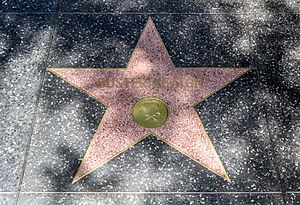
Buster Keaton received an Academy Honorary Award in 1959. He has two stars on the Hollywood Walk of Fame.
Six of his films are kept in the National Film Registry. This means they are considered important to American culture. These films include One Week (1920), Cops (1922), Sherlock Jr. (1924), and The General (1926).
A documentary about his life, Buster Keaton: A Hard Act to Follow (1987), won two Emmy Awards.
The International Buster Keaton Society was started in 1992 on his birthday. This group helps people learn more about his life and work. Its members include many people from the TV and film world. Their nickname, the "Damfinos," comes from a boat in his 1921 comedy, The Boat.
In 1994, the United States Post Office released stamps of silent film stars, including Buster Keaton.
Artist Salvador Dalí called Keaton's films "pure poetry." In 1925, Dalí created a collage called The Marriage of Buster Keaton.
Film critic Roger Ebert said Buster Keaton was the greatest silent clown. He praised Keaton's courage. Filmmaker Orson Welles called him "the greatest of all the clowns in the history of the cinema."
Filmmaker Mel Brooks said Keaton was a major influence on him. He learned a lot from Keaton as a filmmaker. He even borrowed an idea from Keaton's The Cameraman for his own film Silent Movie.
Buster Keaton's film Sherlock Jr., where he walks into a movie, inspired Woody Allen's film The Purple Rose of Cairo.
Actor and stunt performer Johnny Knoxville from Jackass says Keaton inspires him. He even recreated a famous Keaton stunt.
In 2018, the city of Los Angeles declared October 4 "Buster Keaton Day." This honored both Keaton and Charlie Chaplin, who made many silent comedies on the same block.
Filmography
Directed Features:
- Three Ages (1923)
- Our Hospitality (1923)
- Sherlock Jr. (1924)
- The Navigator (1924)
- Seven Chances (1925)
- Go West (1925)
- Battling Butler (1926)
- The General (1926)
- College (1927)
- Steamboat Bill, Jr. (1928)
- The Cameraman (1928)
- Spite Marriage (1929)
Images for kids
See also
 In Spanish: Buster Keaton para niños
In Spanish: Buster Keaton para niños


